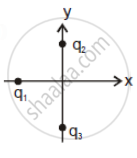Advertisements
Advertisements
प्रश्न
Total charge –Q is uniformly spread along length of a ring of radius R. A small test charge +q of mass m is kept at the centre of the ring and is given a gentle push along the axis of the ring.
- Show that the particle executes a simple harmonic oscillation.
- Obtain its time period.
उत्तर
a. Slight push on q along the axis of the ring gives rise to the situation shown in figure. A and B are two points on the ring at the end of a diameter.
Force on q due to line elements `(-Q)/(2piR)` at A and B is
`F_(A + B) = 2 * (-Q)/(2piR) * q * 1/(4piε_0) * 1/r^2 * cos theta`
= `(-Qq)/(piR.4piε_0) * 1/((z^2 + R^2)) * Z/(z^2 + R^2)^(1/2)`
Total force due to ring on q = `(F_(A + B))(piR)`
= `(-Qq)/(4piε_0) z/(z^2 + R^2)^(3/2)`
= `(-Qq)/(4piε_0)` for z << R

Thus, the force is proportional to the negative displacement. Motion under such forces is harmonic.
b. From (a)

`m (d^2z)/(dt^2) = - (Qqz)/(4piε_0R^3)` or `(d^2z)/(dt^2) = - (Qq)/(4piε_0mR^3)z`
That is `ω^2 = (Qq)/(4piε_0mR^3)`. Hence T = `2pisqrt((4piε_0mR)/(Qq))`
APPEARS IN
संबंधित प्रश्न
How does Ampere-Maxwell law explain the flow of current through a capacitor when it is being charged by a battery?
Two large conducting plates are placed parallel to each other and they carry equal and opposite charges with surface density σ as shown in the figure. Find the electric field (a) at the left of the plates (b) in between the plates and (c) at the right of the plates.

A positive charge q is placed in front of a conducting solid cube at a distance d from its centre. Find the electric field at the centre of the cube to the charges appearing on its surface.
Ionization of a neutral atom is the ______.
In figure two positive charges q2 and q3 fixed along the y-axis, exert a net electric force in the + x-direction on a charge q1 fixed along the x-axis. If a positive charge Q is added at (x, 0), the force on q1 ______.
(1) |
(2) |
A solid sphere of radius R1 and volume charge density `rho = rho_0/"r"` is enclosed by a hollow sphere of radius R2 with negative surface charge density σ, such that the total charge in the system is zero. `rho_0` is a positive constant and r is the distance from the center of the sphere. The ratio R2/R1 is ______.
Given below are two statements:
- Statement I: The electric force changes the speed of the charged particle and hence changes its kinetic energy; whereas the magnetic force does not change the kinetic energy of the charged particle.
- Statement II: The electric force accelerates the positively charged particle perpendicular to the direction of the electric field. The magnetic force accelerates the moving charged particle along the direction of the magnetic field.
In light of the above statements, choose the most appropriate answer from the options given below.
A straight infinitely long cylinder of radius R0 = 10 cm is uniformly charged with a surface charge density σ = + 10-12 C/m2. The cylinder serves as a source of electrons, with the velocity of the emitted electrons perpendicular to its surface. Electron velocity must be ______ × 105 m/s to ensure that electrons can move away, from the axis of the cylinder to a distance greater than r = 103 m.
The electrostatic potential inside a charged spherical ball is given by `Phi = ar^2 + b`, where r is the distance from the centre a, and b are constants. Then the charge density inside the ball is ______.
Two particles A and B having the same mass have charges +q and +4q, respectively. When they are allowed to fall from rest through the same electric potential difference the ratio of their speeds vA to vB will become ______.
